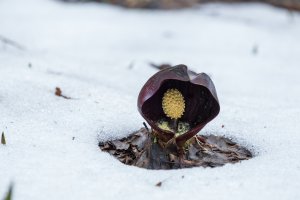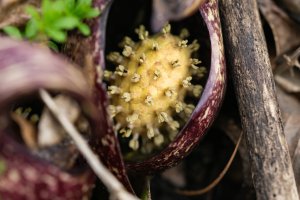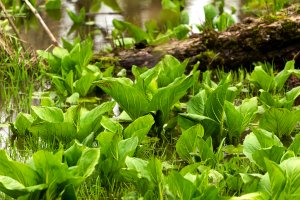Early Plants: Skunk Cabbage
February 22, 2023
Annica Brocker, Park Interpreter
When other plants are still safely tucked away beneath the soil lying dormant, and tree buds are barely starting to form, there is one plant that is showing off its unique bloom even when snow is still on the ground: the eastern skunk cabbage. These otherworldly-looking flowers grow in wetlands and along streams in eastern North America.

The eastern skunk cabbage is a member of the Araceae plant family which includes others such as the common house plants, peace lilies, and monsteras. Like its family members, the eastern skunk cabbage’s pollen originates from a spadix, a projection from the center of the plant, covered in small, yellow spikes. The small spikes are actually the flowers of this plant! Surrounding the spadix is the spathe, a colorful leaf, almost like a single petal. The spathe of the eastern skunk cabbage looks like a curved shell and is often red-purple and mottled with yellow-green spots.
Eastern skunk cabbage is regularly spotted emerging from the snow as early as February. How does a plant push through the snow that, in Michigan, is sometimes hard and crunchy on the topmost layers? Would that not damage the plant, pushing up? Or would the plant not freeze once it is exposed to the cold? Eastern skunk cabbages produce their own heat! When the plants first emerge until it is no longer necessary, a skunk cabbage will keep the air surrounding it consistently between 59° to 95° Fahrenheit higher than the air’s actual temperature. The shape of the spathe also aids in maintaining the warmer temperature.

In addition to its odd appearance and heating characteristics, the eastern skunk cabbage is also known for its uncanny resemblance to its namesake’s stinky smell. The combination of the stinky smell and heat are crucial in attracting the flower’s pollinators: blow flies. Blow flies and other early emerging insects normally eat carrion, which produces an odor equally as stinky as that of the skunk cabbage’s. When the blooms or the big, green leaves are crushed, they give off an odor that many describe as skunk-like. For many park interpreters or naturalists like myself, there is no better way to welcome spring than make a group of unsuspecting parents sniff a skunk cabbage’s leaves brought by their mischievous children!
While this plant is a favorite amongst the pranksters of springtime, indigenous people have used skunk cabbage as a medicinal treatment for several types of ailments. While the eastern skunk cabbage is fairly toxic to humans, causing nausea, dizziness, and vomiting when consumed raw, indigenous peoples would prepare the plant to aid in easing muscle spasms or as an expectorant to clear excess mucus from airways. From 1820 to 1882, skunk cabbage was used in the medicine “dracontium” advertised as a treatment for respiratory conditions, neurological disorders, rheumatism, and dropsy. Some people still use it today!

Humans are not the only species that uses skunk cabbage. Snapping turtles and some insects are of the few animals that can tolerate eating the leaves of skunk cabbage. Black bears, unlike other mammals, will eat the leaves but only in the spring. After a long winter of sleeping on and off with not much going on in the way of bowel movements, black bears will eat skunk cabbage to clear out their digestive systems. Besides being a bear’s choice laxative, clever spiders are sometimes observed building webs across the spathe of the plant. As insects fly towards the yummy smell of the skunk cabbage’s flower, they are trapped by the sticky spider webs. The insects never reached what they thought would be a filling meal, but certainly make themselves a filling meal for the smart spiders.
In the coming weeks while you walk along the rivers, streams, ponds, and creeks of the Metroparks, keep an eye out for these all-around unique flowers native to Michigan. And don’t forget that once the plants show their big, green leaves, enjoy tricking your unaware companions with the “fresh fragrance” of the crushed eastern skunk cabbage!
